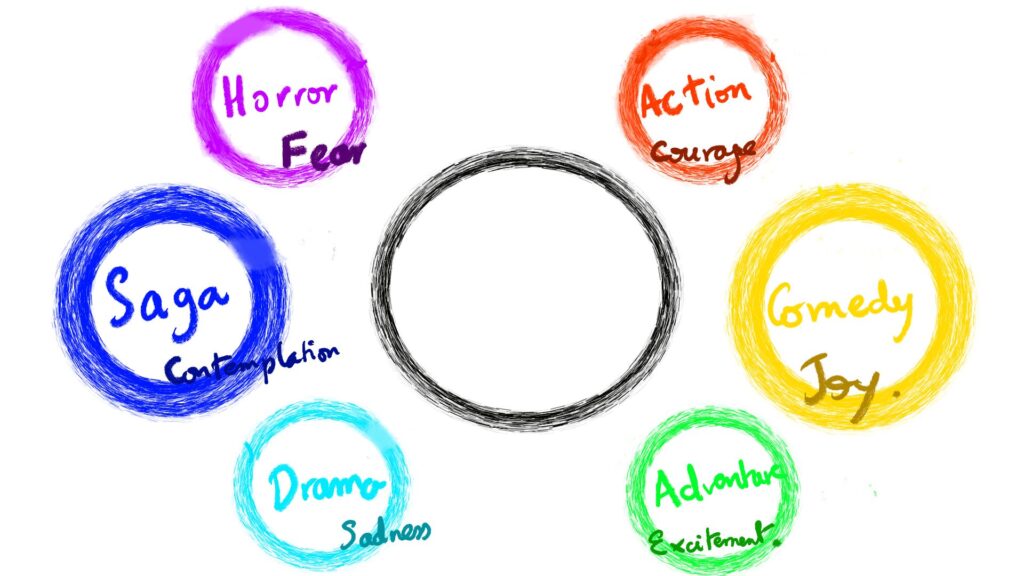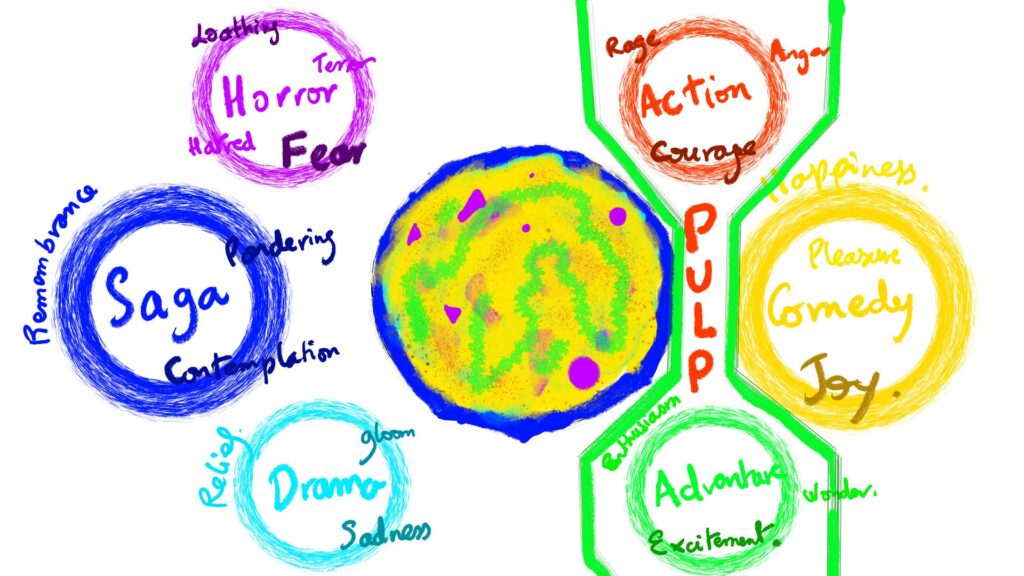
- Does your Story need a Genre?
- Your Story needs Readability.
- A Context conveys this Readability.
- Genre, when Framed, create a Context.
- How do you develop a Context?
Summary – How to Frame your Genre to create a Context?
- Define which Emotion you want to convey.
- Pick the Corresponding Genres.
- Frame these Genre to create a Context.
- Refine your Context by adjusting your Frame.
- Focus on the main Themes.
- Make use of Characters & Environments to create Depth.
A Clear system
- 6 Genres
- Your Stories need Clarity.
- For this you need a Systematic Approach.
- 6 Genres will be enough to provide a Balance between Diversity & Clarity.
- A Clear System should also make Improvisation simpler.
- The Simplicity of this system allows you to Develop Stories more easily.
- Simple Classification is also design to factor the Complexity of modern stories.
- Most Stories you create are likely to fall into multiple genre.
- Therefore, 6 Large categories are more likely to define your Storyline than 1 Narrow category.
- Target Emotions
- Your Stories will convey Emotions.
- Either Strong or Reactive Emotions – Anger/Courage, Fear, Excitement.
- Or Deep or Contemplative Emotions – Sadness, Contemplation, Joy.
- Classifying Emotions may be a confusing task.
- It is why your need a sturdy base.
- Here, 1 Genre will correspond to 1 Emotion:
- Action – Courage
- Comedy – Joy
- Adventure – Excitement
- Drama – Sadness
- Saga (Action-Adventure) – Contemplation
- Horror – Fear
- All of the Aforementioned are considered as Fundamental Emotions.
- These are the Emotions you’ll want to Target 1st.
- From there you can extend.
- ex: Fear – Anxiety, Dread, Abomination, Terror, Revilement and so on…
- Combine Genres to Merge Emotions.

If you want to know more about Story Structures.
The 6 Genres – If Fiction was a Pizza
- The Pizza Parable
- Your Stories are the Best.
- They are Scalable.
- Small – 1 shot
- Medium – Trilogy
- Large – Saga
- They are Customizable.
- You can adapt & adjust them.
- By adding or removing Characters, Items & Environments.
- They are Sharable.
- Your Stories are Collective Stories.
- You build them with your Team, with the Public & with the Characters.
- You want to Share them.
- Because they represent your Ideal.
- You Write them so that they taste delicious for you.
- Chances are high that they taste good for others.
- My Pizza
- How’s fiction your Pizza?
- Here.
- Action-Adventure or Saga, is The Dough.
- Comforting & Flexible.
- Action, the Spices.
- Put it where you need more Punch.
- Adventure, the Herbs.
- For more Flavor & Freshness.
- Comedy, the Cheese.
- Too much and you’ve got a bowel incident.
- Drama, the Sauce or the cream.
- Can submerge all the others.
- Horror, the Meat.
- Delicious in moderation.
- Start with the Dough
- If you don’t know what to begin with Start with Action-Adventure.
- Sagas are Universal Stories compelling Humans because they balance Emotions.
- There’s a sense of Familiarity in Sagas.
- They’re also the most Flexible stories.
- They’re Experimentation Stations.
- If you’re not sure of which Genre pick start with a Saga.
- And create a Place where the Public wants to Return.
- Sagas are Homes.
- The Dough is Home.
If you want to know more about Diversity.
Framing & Context
- What are the Most Popular Frames?
- Science Fiction
- Fantasy
- Mystery
- Thriller
- Western
- Pirate
- Monsters
- War
- How can you can make use of them?
- Frames define your Stories borders.
- They give the Public a definition of your Stories.
- The Themes you will be Displaying & Unfolding.
- Framing a Story allows you to create a Context.
- How to Frame a Genre?
- Pick your Genres.
- Pick your Frame.
- Here are 3 Examples.



Creating a Context & Immersion
- 3 Purposes
- A Context serves 3 Purposes:
- It create Predictability & Expectations.
- It allows the Story to be more Readable.
- It create a sense of Familiarity & Belonging.
- Immersion
- Combining Genres & Frames helps the Public to Immerse themselves in Stories.
- Context deliver both Coherence & Consistency.
- Which are both essential to develop a World.
- Genre + Frame = Context
- Here’s a Table of Possible combination of the aforementioned Genres & Frames.
| Context | Science-Fiction | Fantasy | Mystery | Thriller | Western | Pirate | Monsters | War |
| Action | Swashbuckler | Paranormal | Hardboiled | Assault | Wilderness | Swashbuckler | Beast | Military |
| Adventure | Pulp | High Fantasy | Espionage | Vigilante | Romance | Romance | Trials | Conquest |
| Comedy | Blue Comedy | Farce | Burlesque | Satire | Screwball | Screwball | Clown | Satire |
| Drama | Apocalypse | Fable | Film Noir | Disaster | Lonesome | Clans/Crew | Shadow | Anthology/Memoires |
| Sagas | Space Opera | Epic | Detective | Police Procedural | Frontier | Clans/Crew | Nemesis | Clans/Factions |
| Horror | Dystopia | Dark Fantasy | Crime | Hatred | Isolation | Survival | Cannibal | Survival |
